.net 溫故知新:【10】.NET ORM框架EFCore使用入門之CodeFirs、DBFirst
前言:本系列是我自己學習.net相關知識,以便跟上.net跨平臺的步伐,目前工作原因基本在.net Framework4.7以下,所以才有了這一系列的學習總結,但是並不是從基本的C#語法和基礎知識開始的,而是圍繞.net core以後平臺的重要設計和差異進行溫故知新。目的在於通過要點的梳理最後串聯起整個跨平臺框架。之前的幾篇算是把框架重要設計和框架重要知識點複習了,當然什麼系統都可能使用到ORM框架。所以這裡為了整個過程的完整連續性加入一個EFCore的範例,ORM不算詳細寫了,畢竟ORM框架可以根據需求選擇很多,如果再詳細那又是另外一個系列了,這裡只做簡單介紹。從這篇ORM完成之後就將進入asp.net core的學習總結!
EFCore
Entity Framework Core (EF Core) 是適用於 .NET 的新式物件資料庫對映器。 它支援 LINQ 查詢、更改跟蹤、更新和架構遷移。
EF Core 通過資料庫提供程式外掛模型與 SQL Server/Azure SQL 資料庫、SQLite、Azure Cosmos DB、MySQL、PostgreSQL 和更多資料庫配合使用。
EFCore入門
在上面的EFCore介紹中我們又看到了提供程式描述,之前文章多次提到這個提供程式是.net框架中隨處可見的,也就是通過這些不同的提供程式實現擴充套件和適配。本文我用兩種資料庫,sqlite和sqlserver並分別用code-first(程式碼優先)模式和db-frist(資料庫優先)模式演示EFCore的使用。
1、Code First
新建一個.net 6.0 控制檯應用程式,安裝nuget包(EFCore的sqlite提供程式):
Install-Package Microsoft.EntityFrameworkCore.Sqlite
重要依賴Package Microsoft.EntityFrameworkCore包會自動安裝。
編寫SqliteContext類構成模型的上下文類,實體類:Student、Course。
namespace EFCoreDemo.Sqlite
{
public class SqliteContext : DbContext
{
public DbSet<Student> Students { get; set; }
public DbSet<Course> Courses { get; set; }
/// <summary>
/// sqlite 資料庫檔案路徑
/// </summary>
public string DbPath { get; }
public SqliteContext()
{
var folder = Environment.CurrentDirectory;
DbPath = System.IO.Path.Join(folder, "CodeFirst.db");
}
protected override void OnConfiguring(DbContextOptionsBuilder options)
=> options.UseSqlite($"Data Source={DbPath}");
}
/// <summary>
/// 學生
/// </summary>
public class Student
{
public int id { get; set; }
public string name { get; set; }
public List<Course> courses { get; set; }
}
/// <summary>
/// 課程
/// </summary>
public class Course
{
public int id { get; set; }
public string name { get; set; }
}
}
接著我們安裝包Microsoft.EntityFrameworkCore.Tools用來生成資料庫
Install-Package Microsoft.EntityFrameworkCore.Tools
然後在「包管理器控制檯(PMC)」中使用命令:
Add-Migration InitialCreate
提示建立成功:
PM> Add-Migration InitialCreate
Build started...
Build succeeded.
To undo this action, use Remove-Migration.
PM> Update-Database
Build started...
Build succeeded.
Applying migration '20221130040124_InitialCreate'.
Done.
搭建基架,為模型建立一組初始表。該命令完成後會生成一個Migration資料夾包含兩個類,一個資料庫建立類InitialCreate是我們定義的,可以按需求更改名稱。一個模型快照類SqliteContextModelSnapshot上面的[DbContext(typeof(SqliteContext))]屬性標識類所屬的DbContext。使用該atrribute確定遷移應用於哪個上下文。
由於這是專案的第一次遷移,如果我們修改了模型後再Add-Migration生成的時候EFCore 會在新增列之前將更新的模型與舊模型的快照進行比較。基於該比較,EF Core 檢測變化,並新增適當的遷移而不是再重新生成資料庫。
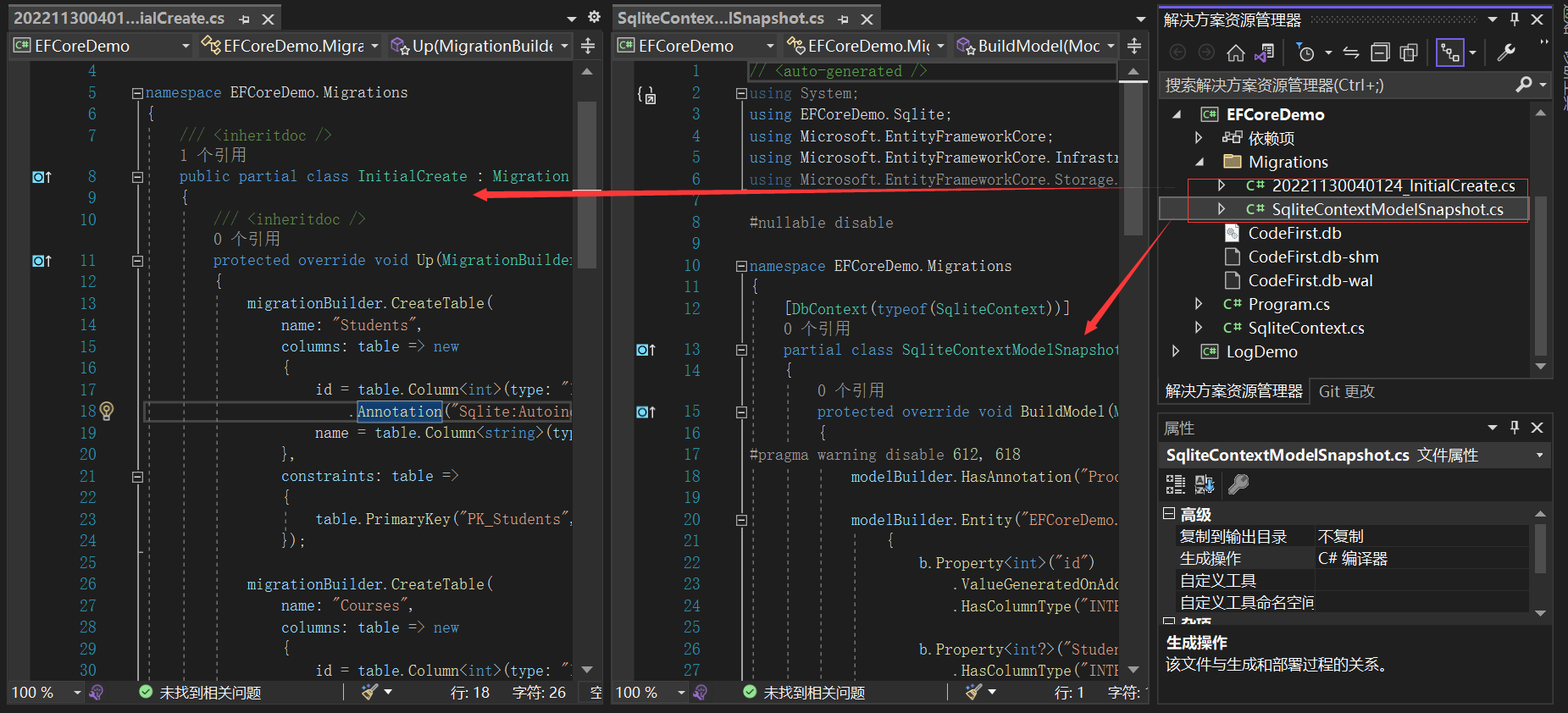
最後執行命令Update-Database生成資料庫和表,資料庫在我們設定的程式路徑下。
PM> Update-Database
Build started...
Build succeeded.
Applying migration '20221130040124_InitialCreate'.
Done.

生成的sqlite資料庫如圖,因為我們定義了Student、Course實體,所以會生成兩個表以及表的欄位,同時還會生成一個歷史表,用於記錄我們每次遷移的記錄。另外在Student類裡面我們定義了一個public List<Course> courses { get; set; } 屬性,表示學生擁有哪些課程,這樣相當於是一個外來鍵關係,EFCore會為我們在Coures表裡面建立一個Sudentid的外來鍵來表達關聯關係。同時我們查詢學生的話理論上也能查出學生擁有的課程,接下來我們向資料庫中插入資料並進行查詢。
注意在命令生成的時候CurrentDirectory是專案目錄,我們執行的時候要把生成的CodeFirst.db複製到bin/debug。
static void Main(string[] args)
{
//範例化context
SqliteContext context = new SqliteContext();
//新增資料
for (int i = 0; i < 5; i++)
{
List<Course> courses = new()
{
new Course()
{
name = "語文"+i
},
new Course()
{
name = "數學"+i
},
};
context.Students.Add(new Student()
{
name = "學生" + i,
courses = courses
});
context.SaveChanges();
}
//查詢
var students = context.Students.Include(t=>t.courses).ToList();
students.ForEach(e =>
{
Console.Write(e.name);
e.courses.ForEach(e => { Console.Write(e.name); });
Console.WriteLine();
});
var student = context.Students.SingleOrDefault(t => t.name=="學生3");
Console.WriteLine($"id:{student.id},name:{student.name}");
Console.ReadKey();
}
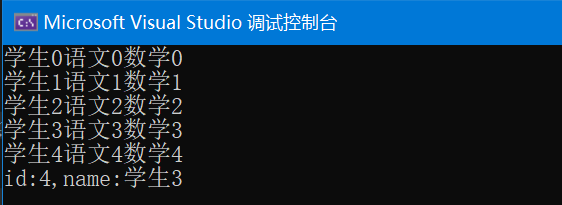
查詢如果要包含外來鍵關聯的資料,需要用
Include方法。不然上面的結果第一次可以用,第二次就查詢不出來,因為第一次的資料新增後會直接在上下文Context裡面。
2、 DB Frist
首先我們建一個sqlserver資料庫,然後反向建兩張一樣的表。
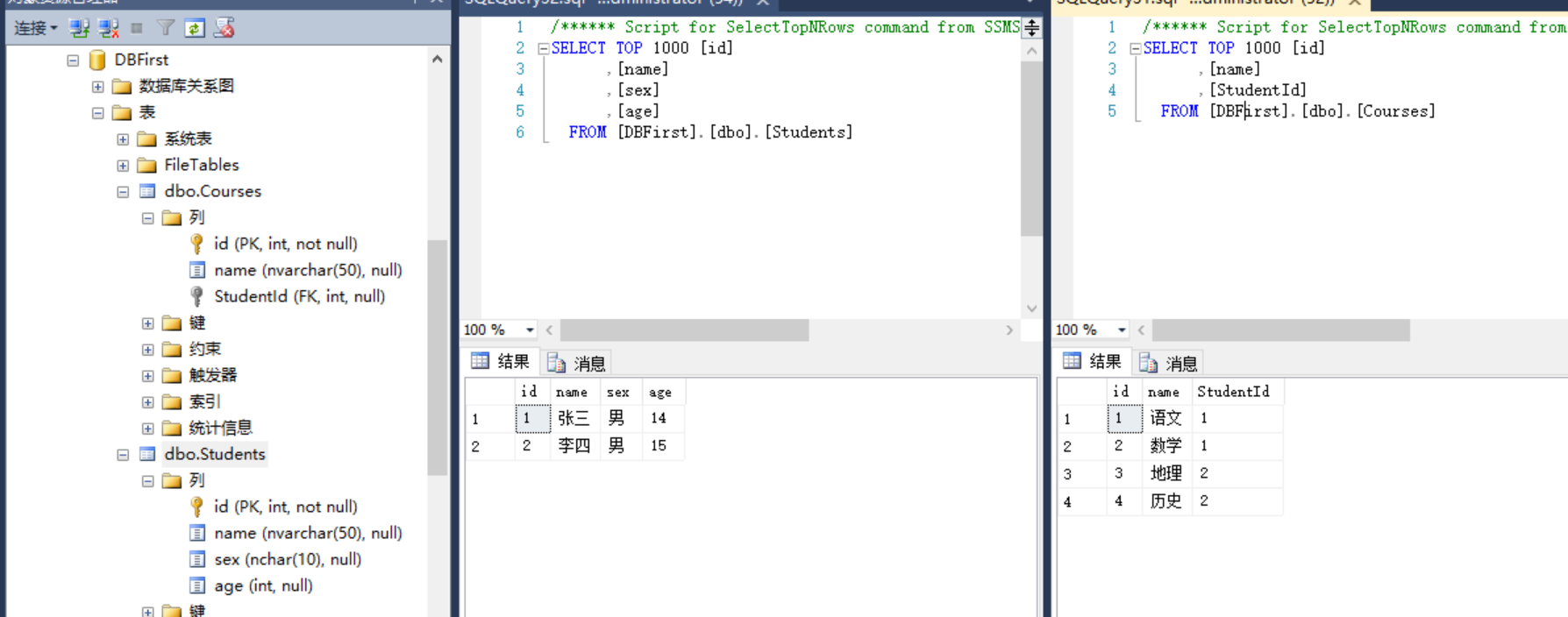
在專案中安裝 Microsoft.EntityFrameworkCore.Design 的 nuget 包。
Install-Package Microsoft.EntityFrameworkCore.Design
由於上面我安裝Microsoft.EntityFrameworkCore.Tools nuget包的時候依賴項已經安裝了所以就不需要再安裝了。
然後安裝sqlserver的提供程式 nuget 包。
Install-Package Microsoft.EntityFrameworkCore.SqlServer
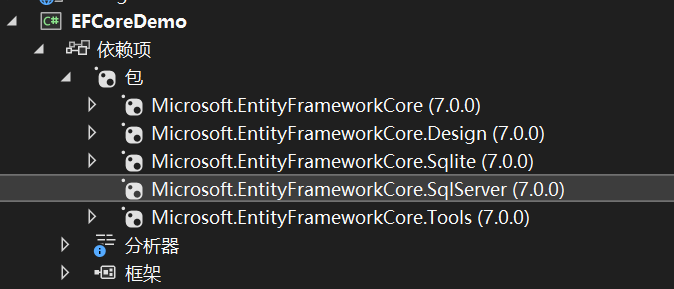
安裝好 nuget 包後在程式包管理器控制檯裡面使用命令:
Scaffold-DbContext 'Data Source=192.168.40.165;Initial Catalog=DBFirst;User Id=sa;Password=123456;Encrypt=False' -Context SqlServerContext -OutputDir DBFirst Microsoft.EntityFrameworkCore.SqlServer
- -Context:指定DbContext 類名稱,如果不指定則是資料庫名稱+Context。
- -OutputDir:指定生成的模型目錄。
除此之外該命令還有其它引數包括:
- -ContextDir:指定DbContext類生成目錄。
- -ContextNamespace:覆蓋 DbContext 類的名稱空間。
- -Namespace: 覆蓋所有輸出類的名稱空間。
生成的DBContext和模型:
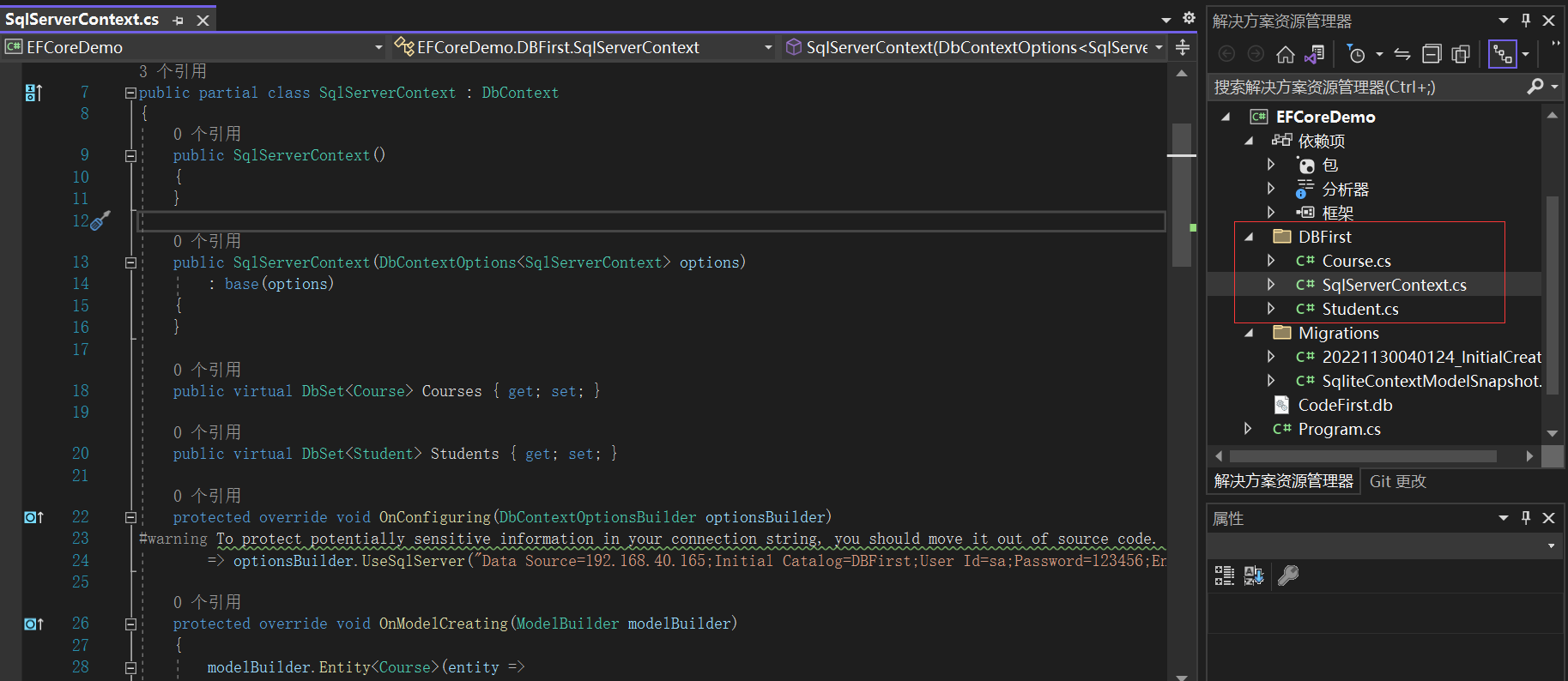
使用SqlServerContext 查詢資料:
var students = context.Students.Include(t=>t.Courses).ToList();
students.ForEach(e =>
{
Console.Write(e.Name);
e.Courses.ToList().ForEach(e => { Console.Write(" "+e.Name); });
Console.WriteLine();
});
var student = context.Students.SingleOrDefault(t => t.Name=="李四");
Console.WriteLine($"id:{student.Id},name:{student.Name}");
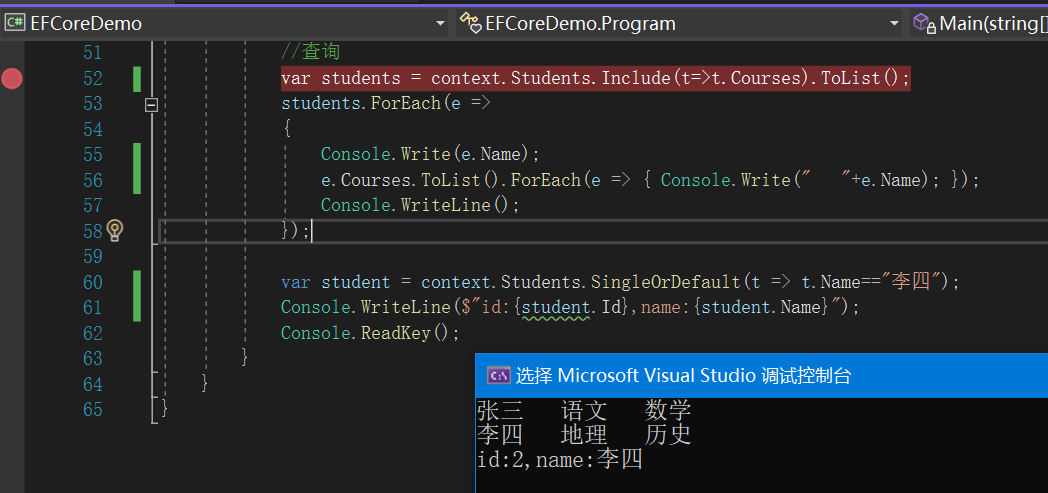
EFCore的其它重要知識點
本篇作為入門使用,其它EFCode的重要知識點還是建議使用時候檢視官方檔案即可。
我認為EFCore的重要知識點包括但不限於:
- EFCore中的約定大於設定,比如模型如果有Id欄位預設就是主鍵。
- 一對多關係設定和獲取,上面範例中學生有哪些課程就是一對多,查詢關聯要用includ。
- 多個外來鍵欄位的設定。
- 一對多,多對多關係。
- Iqueryable的作用和資料延遲載入,在我們查詢資料的時候列表資料以Iqueryable型別返回,如果我們不是呼叫獲取結果api,則不會立即查詢資料庫,而是等到使用tolist()、count()、max()等方法時才會查詢資料返回結果。這樣有利於我們在程式碼中複用Iqueryable,比如不同的if條件拼接後組成不同的查詢語句。
- EFcore 快取。
- AsNoTracking使用,EFCore預設會跟蹤實體,也就是儲存在記憶體中,用於更新刪除等操作。如果只是查詢資料而不用跟蹤則使用AsNoTracking查詢。
- 並行控制。
.....
作者:SunSpring
出處:https://www.cnblogs.com/SunSpring/p/16935713.html
本文版權歸作者所有,歡迎轉載,但未經作者同意需在文章頁面明顯位置給出原文連結。